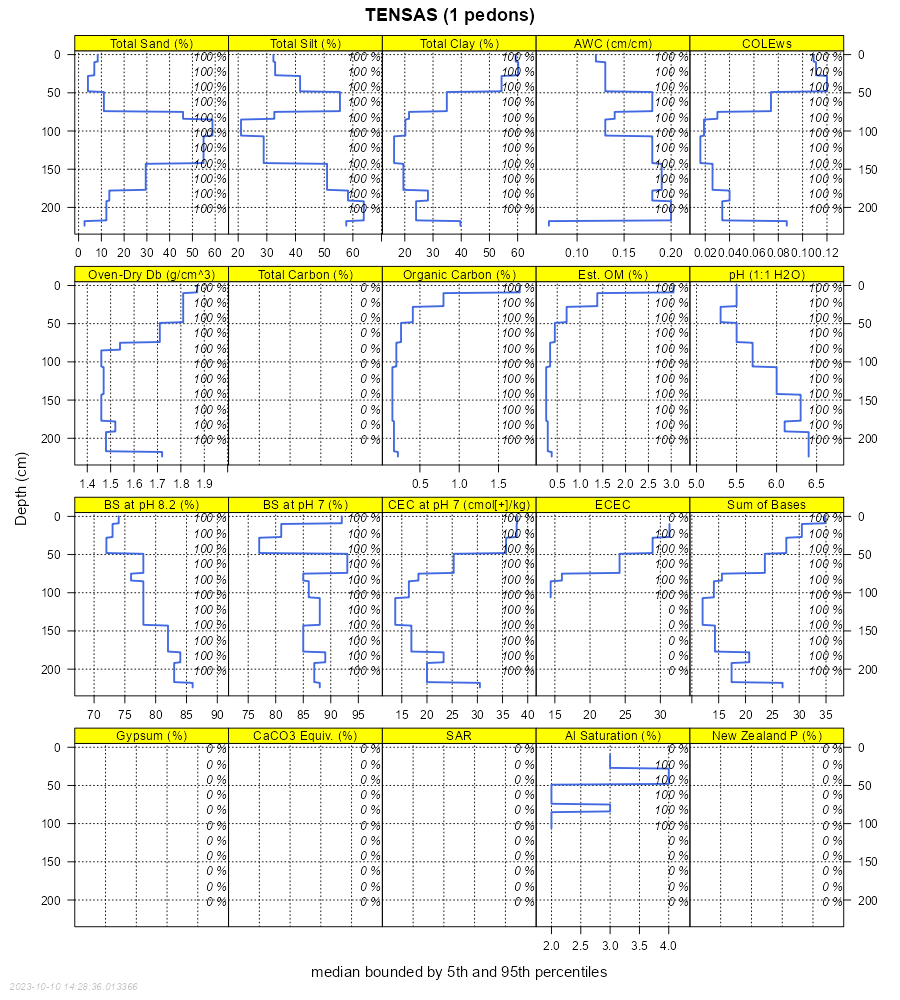| Tensas-Sharkey complex, overwash, undulating, occasionally flooded | Ts | 24686 | 1711971 | 1vgfw | la009 | 1981 | 1:24000 |
Tensas silty clay, overwash, occasionally flooded | Te | 10456 | 1711969 | 1vgft | la009 | 1981 | 1:24000 |
Tensas-Sharkey complex, undulating | Tn | 4658 | 1711970 | 1vgfv | la009 | 1981 | 1:24000 |
Tensas silty clay, 0 to 1 percent slopes, rarely flooded | Ta | 3666 | 1711968 | 2v189 | la009 | 1981 | 1:24000 |
Tensas silty clay loam | Bd | 834 | 1715806 | 1vlfl | la009 | 1981 | 1:24000 |
Tensas-Alligator complex, undulating | Tn | 25467 | 1722428 | 1vtb6 | la025 | 1983 | 1:24000 |
Tensas silty clay, 0 to 1 percent slopes, rarely flooded | Ta | 12446 | 1722426 | 2v189 | la025 | 1983 | 1:24000 |
Tensas-Alligator complex, undulating, occasionally flooded | Ts | 11413 | 1722429 | 1vtb7 | la025 | 1983 | 1:24000 |
Tensas silty clay, occasionally flooded | Te | 3708 | 1722427 | 1vtb5 | la025 | 1983 | 1:24000 |
Tensas-Alligator complex, undulating | To | 64351 | 1723886 | 1vvv7 | la029 | 1983 | 1:24000 |
Tensas-Alligator complex, undulating, occasionally flooded | Tr | 17320 | 1723887 | 1vvv8 | la029 | 1983 | 1:24000 |
Dundee-Alligator-Tensas complex, gently undulating | Dh | 12388 | 1723869 | 1vvtp | la029 | 1983 | 1:24000 |
Dundee-Alligator-Tensas complex, undulating | Ds | 10959 | 1723870 | 1vvtq | la029 | 1983 | 1:24000 |
Tensas silty clay, 0 to 1 percent slopes, rarely flooded | Tc | 10485 | 1723884 | 2v189 | la029 | 1983 | 1:24000 |
Tensas silty clay, occasionally flooded | Te | 2908 | 1723885 | 1vvv6 | la029 | 1983 | 1:24000 |
Tensas silty clay, 0 to 1 percent slopes, rarely flooded | Ta | 12348 | 569504 | 2v189 | la035 | 1985 | 1:24000 |
Tensas-Dundee complex, gently undulating | Td | 9224 | 569505 | m3m4 | la035 | 1985 | 1:24000 |
Tensas-Sharkey complex, 0 to 3 percent slopes, gently undulating | Te | 3155 | 569506 | 2sscs | la035 | 1985 | 1:24000 |
Tensas-Sharkey complex, 0 to 3 percent slopes, gently undulating | Ts | 6722 | 1711116 | 2sscs | la041 | 1979 | 1:24000 |
Tensas silty clay, 0 to 1 percent slopes, rarely flooded | Te | 5501 | 1711115 | 2v189 | la041 | 1979 | 1:24000 |
Tensas silty clay, occasionally flooded | Te | 1330 | 1600194 | 1qq45 | la059 | 1986 | 1:24000 |
Tensas-Sharkey complex, 0 to 3 percent slopes, gently undulating | Ts | 59753 | 808558 | 2sscs | la065 | 1972 | 1:24000 |
Tensas silty clay, 0 to 1 percent slopes, rarely flooded | Ta | 11312 | 808557 | 2v189 | la065 | 1972 | 1:24000 |
Tensas-Sharkey complex, 0 to 3 percent slopes, gently undulating | Ts | 1468 | 1714808 | 2sscs | la083 | 1988 | 1:24000 |
Dundee-Tensas complex, gently undulating | Ds | 1258 | 1714772 | 1vkc7 | la083 | 1988 | 1:24000 |
Tensas silty clay, 0 to 1 percent slopes, rarely flooded | Tc | 213 | 1714807 | 2v189 | la083 | 1988 | 1:24000 |
Tensas-Sharkey complex, gently undulating | Ts | 13130 | 823559 | wmzf | la097 | 1983 | 1:24000 |
Tensas silty clay loam, 0 to 1 percent slopes | Te | 25745 | 1451683 | 1kqlh | la099 | 1974 | 1:24000 |
Tensas-Sharkey clays, 0 to 3 percent slopes, gently undulating | TeB | 111023 | 577263 | 2sscr | la107 | 2001 | 1:24000 |
Tensas-Sharkey-Dundee complex, gently undulating | TkB | 19476 | 578950 | mfft | la107 | 2001 | 1:24000 |
Tensas clay, 0 to 1 percent slopes | TaA | 12867 | 577262 | mcpc | la107 | 2001 | 1:24000 |
Tensas-Sharkey complex, undulating | TeD | 3369 | 577258 | mcp7 | la107 | 2001 | 1:24000 |
Tensas silty clay loam, 0 to 1 percent slopes, occasionally flooded | Te | 10539 | 2693431 | 2rv5x | ms051 | 1997 | 1:20000 |
Alligator, Tensas, and Dowling soils, frequently flooded | ATF | 4342 | 567943 | m1zr | ms051 | 1997 | 1:20000 |
Tensas silty clay loam, 0 to 1 percent slopes | 27 | 42602 | 568122 | m25j | ms083 | 1997 | 1:24000 |
Tensas-Alligator complex, 0 to 3 percent slopes, occasionally flooded | 30 | 23308 | 568125 | m25m | ms083 | 1997 | 1:24000 |
Alligator, Tensas, and Dowling soils, frequently flooded | 7 | 19494 | 568120 | m25g | ms083 | 1997 | 1:24000 |
Tensas silty clay loam, 1 to 3 percent slopes | 28 | 13037 | 568123 | m25k | ms083 | 1997 | 1:24000 |
Tensas-Alligator-Urban land complex, 0 to 3 percent slopes | 31 | 4385 | 568126 | m25n | ms083 | 1997 | 1:24000 |
Tensas silty clay loam, 3 to 8 percent slopes | 29 | 1297 | 568124 | m25l | ms083 | 1997 | 1:24000 |
Dundee and Tensas silt loams, 0 to 3 percent slopes | DtA | 14509 | 568520 | m2lc | ms135 | 1966 | 1:24000 |
Tensas silty clay loam, 0 to 2 percent slopes | 120 | 17690 | 1715963 | 1vlln | ms143 | 2006 | 1:24000 |
Askew-Tensas-Openlake complex, undulating | 116 | 6688 | 1715962 | 1vllm | ms143 | 2006 | 1:24000 |
Tensas-Sharkey complex, undulating | 278 | 2614 | 1715974 | 1vlm0 | ms143 | 2006 | 1:24000 |











